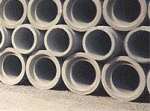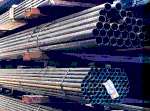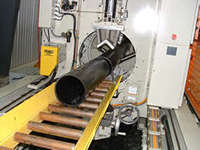
|
a |
|
- |
|
- |
|
- |
| careers |
|
|||||||||||||||||||||||||||||||||||||||||||||||||||||||||||||||||||||
|
Light Weight |
easy to handle and move |
|
Non-Corrosive |
will not rust or corrode |
|
Smooth Inner Surface |
prevents clogging or blockages |
|
Flexibility |
can bend without fittings |
|
Chemical Resistance |
resistance to acids and alkalis in soils |
|
Simple Joining Procedure |
heat fusion for leak free joints |
 Plastic
Pipe vs Concrete Pipe
Plastic
Pipe vs Concrete Pipe
Concrete pipe continues to be the pipe of choice when durability,
structural strength, long service life, and low maintenance are
required. As a rigid pipe solution, the strength of concrete pipe
reduces the bedding and backfill requirements compared to plastic
pipe. Since concrete itself serves as a structure, it is not as
dependent as plastic pipe on its surrounding conditions.
Most cities in North America use concrete pipe in their water systems. While durability is cited as the main reason for choosing concrete, it also considered one of the safest piping material available. It doesn't burn or rust and will significantly reduce the risk and any potential liability associated with a fire related catastrophe. While concrete is superior in certain ways, plastic pipe is often more abrasion and chemically resistant, and has a better flow capacity than concrete pipe, As to which is better, the final selection will usually be based on a choice between the cost of installing the much heavier and rigid concrete pipe and the much lighter and flexible plastic pipe. Plastic's light weight also permits the use of longer sections, and cutting the pipe at the job site, resulting in easier and shorter installations.
 Plastic
Pipe vs Metal Pipe
Plastic
Pipe vs Metal Pipe
In most cases, plastic pipe is a viable replacement for metal pipe.
There is no doubt that it is cheaper to install plastic pipe than
metal pipe. In a lot of cases, plastic would not only do the job,
it would do it better.
In the first place, plastic is more resistant to corrosion than
metal. A plastic piping system will never jam, stick or fail because
of rust or corrosion. Plastic valves never have to be painted to
withstand corrosive environments or harsh climatic conditions. They
can be installed and used right out of the box in places where a
metal valve would have to be epoxy coated just to survive. A second
advantage involves flow rates. The inside of plastic pipe is smooth
and clean and it will stay that way for years. Metal pipe can rust
, corrode and scale - resulting in reduced flow rates and higher
pressure drops over time. Users of metal pipe, valves and fittings
are often concerned with they believe are the mechanical strength
limitations of plastics.While it is true that there is isn't a plastic
system that can match the temperature and pressure service levels
of a metal piping system, few realize that plastic piping systems
can provide adequate tensile strength or operation up to 200°
F.
 Hdpe vs PVC
Hdpe vs PVC
PVC, a rigid plastic pipe, is often thought to be quite similar
to hdpe pipe. While both have good flow capacity rates, and are
available in longer lengths and greater diameters, both also can
be buried underground and transfer their loads the surrounding soil,
hdpe is a flexible piping material. Equally
resistant to chemical corrosion compared to metal or concrete, hdpe
is highly abrasion resistant, while PVC is only moderately abrasion
resistant, and hdpe is less susceptible to surge shocks than PVC.
In general, while PVC is stiffer than hdpe pipe, it is more brittle
than hdpe making it vulnerable to shipping and handling damage.
The biggest difference is that PVC has environmental issues that hdpe doesn't (PVC is made using chlorine which is a carcinogenic material) and are joined together by gaskets while hdpe is welded. Because it is chlorine free, hdpe pipe requires fewer additives to make. Unlike PVC pipe, hdpe pipe is also dioxin free the most potent carcinogen around. When it comes to the environment, hdpe pipe is a much more benign plastic. As such hdpe pipe is considered a viable alternative for some pipe and conduit applications typically reserved for PVC. It's flexibility results in fewer ruptures from freezing and construction around the pipes making it a popular piping material for stormwater and irrigation applications.
|
PVC |
ABS |
HDPE |
|
|
Durability |
Decades |
Decades |
Decades |
|
Joining |
Solvent |
Solvent |
Fusion |
|
Joint Integrity |
Leak Free |
Leak Free |
Leak Free |
|
Weight |
Light |
Light |
Lighter than PVC |
|
Flexibility |
flexible |
flexible |
flexible |
|
Internal Wall Smoothness |
Good |
Good |
Good |
|
Tensile Strength |
Fair |
Fair |
Fair |
|
Abrasion Resistance |
Fair |
Fair |
High |
|
Chemical Resistance |
Fair |
Fair |
High |
|
Impact Resistance |
Fair |
Fair |
High |
|
Fire Resistance |
Fair |
Fair |
Fair |
|
Operating Temperature |
-40°C to +65°C |
-40°C to +80°C |
0°C to +60°C |
Applications of Plastic Pipe
Plastic pipe found its first use in the construction and building industires. The building industry continues to be a large user of plastics, accounting for 400,000,000 lb. in 1955. Most engineers now realize that plastics are not merely substitutes for other conventional engineering materials. Their unique properties and production methods make possible the fabrication of building components by entirely new procedures and in designs departing markedly from those formerly used. Plastic, as a piping material, is chosen primarily for its lightweigh, chemical resistance, and non-corrosive properties. The primary applications in which plastic piping is used include the following:
Non Pressure Applications
Drainage
Building Drain, Waste and Vent (DWV)
Building Sewers and Drains
Pressure Applications
Industrial Processes
Water Service
Hot and Cold Water Distribution
Other
Fire Sprinkler Piping
Swimming Pool Piping
Chilled Water Systems
Irrigation
Ice Melting
Radiant Floor Heating
Contact
us today by email or our toll free number:
sales@oxfordplasticsinc.com
1.800.263.0502
|
Copyright ® 2003 - 2008 | Oxford Plastics Inc. | All Rights Reserved |
|||
|
Oxford Plastics Inc. ~ PO Box 119, Oxford Road 6, Embro, Ontario, CANADA, N0J 1J0 |
|||
|
Office: 519.423.6232 ~ Fax: 519.423.6057 ~ Toll Free: 1.800.263.0502 |
 Plastic
Pipe
Plastic
Pipe